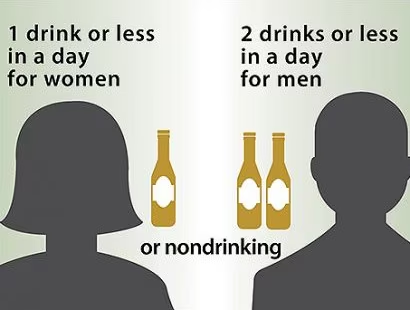Addressing Excessive Alcohol Use: State Fact Sheets
Excessive alcohol use is responsible for about 178,000 deaths in the United States each year and it shortens the lives of those who die by an average of 24 years. Excessive alcohol use was associated with an economic cost of $249 billion in 2010. The Community Preventive Services Task Force recommends evidence-based strategies to prevent excessive alcohol use and related harms at the population level, including increasing alcohol taxes, regulating the number and concentration of places that sell alcohol, and having other policies that reduce the availability and accessibility of alcohol.
CDC works with states and communities to prevent excessive alcohol use and its impact. These fact sheets highlight the public health problem and the status of alcohol policy solutions in each of the 50 states and the District of Columbia.
stateName
Excessive alcohol use can harm your health. It includes binge drinking, defined as consuming 5 or more drinks for men or 4 or more drinks for women on an occasion, heavy drinking, defined as 15 or more drinks for men or 8 or more drinks for women per week, and any alcohol use by pregnant women or people younger than 21.
Drinking too much is associated with:1
- Violence.
- Sexual risk behaviors.
- Alcohol poisoning.
- Injuries, such as motor vehicle crashes.
- Cancer.
- Liver disease.
- High blood pressure.
- Alcohol use disorder.
stateName2: The Numbers
deaths1
More than deaths2
Average number of deaths from excessive drinking each year.
Source: Alcohol-Related Disease Impact application, during 2020–20212
$costsTotal
or costsPerDrink per drink sold
Annual economic cost of excessive drinking due to lost productivity, criminal justice, and health care costs in 2010.3
totalTax1
Total federal and state alcohol taxes in 2010.4
NATIONAL
17%
stateName4
bingePreAdults%
Percentage of adults who binge drink.
Source: Behavioral Risk Factor Surveillance System, brfssYr5
NATIONAL
11%
stateName5
bingePrevHS
Percentage of high school students who binge drink.
intensity75-1+ drinks
per occasion
Among adults in stateName6 who binge drink, 25% consume at least intensity75-2 drinks per binge drinking occasion.
Source: Behavioral Risk Factor Surveillance System, brfssYr5
frequency75-1+ times
per month
Among adults in stateName6 who binge drink, 25% do so at least frequency75-2 times per month.
Source: Behavioral Risk Factor Surveillance System, brfssYr5
What Works to Prevent Excessive Alcohol Use
The Community Preventive Services Task Force—an independent, nonfederal, volunteer body of public health and prevention experts—recommends several evidence-based strategies to reduce excessive alcohol use and related harms at the population level. These strategies can help communities create social and physical environments that encourage drinking less alcohol. Use of these strategies can reduce binge drinking and related outcomes, such as motor vehicle crashes, injuries, violence, and sexually transmitted infections.
Regulate Alcohol Outlet Density
Alcohol outlet density refers to the number and concentration of alcohol retailers (such as bars, restaurants, and liquor stores) in an area. Greater alcohol outlet density is associated with excessive alcohol use and related harms, including injuries and violence.7 Some states have local authority to regulate outlets at the local level, while in others, it is controlled by the state.
- density8,9
Increase Alcohol Taxes
Alcohol taxes affect the price of alcohol and can reduce alcohol consumption, raise revenue, or both. Alcohol taxes can include excise, ad valorem, or sales taxes at the local, state, or federal level, all of which affect the price of alcohol.10
- beerTax11 localAuthorityTax12,13
Have Commercial Host (Dram Shop) Liability Laws
Commercial host liability, also known as dram shop liability, refers to laws that hold alcohol retailers liable for injuries or harms caused by illegal service to intoxicated or underage customers.14
- dramShop15,16
Maintain Limits on Days and Hours of Sale
States or localities may limit the days or hours that alcohol can legally be sold or served.17,18 These laws may apply to on-premises retailers (such as bars, restaurants, or clubs where alcohol is consumed on-site) or off-premises retailers (such as liquor, convenience, or grocery stores where alcohol is consumed off-site).
- daysHours19
Privatize Retail Alcohol Sales (recommended against)
The privatization of alcohol retail sales refers to the government allowing private, nongovernment retailers to sell alcoholic beverages (beer, distilled spirits, or wine).20
- retailControl11
Enhanced Enforcement of Laws Prohibiting Sales to Minors
The minimum legal age when an individual can purchase alcoholic beverages is 21 years. An enhanced enforcement program initiates or increases compliance checks at alcohol retailers (such as bars, restaurants, and liquor stores).21,22
Dietary Guidelines for Americans

The Dietary Guidelines for Americans 2020-2025 recommends that adults of legal drinking age can choose not to drink or to drink in moderation by limiting intake to 2 drinks or less in a day for men or 1 drink or less in a day for women on days when alcohol is consumed. Drinking less is better for health than drinking more.23
Additional Resources for Preventing Excessive Drinking
- Centers for Disease Control and Prevention. Alcohol Use and Your Health. Accessed November 22, 2022. https://www.cdc.gov/alcohol/fact-sheets/alcohol-use.htm
- Centers for Disease Control and Prevention. Alcohol-Related Disease Impact (ARDI). Accessed February 29, 2024. https://www.cdc.gov/ardi
- Sacks JJ, Gonzales KR, Bouchery EE, Tomedi LE, Brewer RD. 2010 National and state costs of excessive alcohol consumption. Am J Prev Med. 2015;49:e73–e79.
- Blanchette JG, Chaloupka FJ, Naimi TS. The composition and magnitude of alcohol taxes in states: do they cover alcohol-related costs? J Stud Alcohol Drugs. 2019;80:408–414.
- Centers for Disease Control and Prevention. Behavioral Risk Factor Surveillance System. Accessed November 13, 2023.
- Centers for Disease Control and Prevention. Youth Risk Behavior Surveillance System: Youth Online High School Results. Accessed September 13, 2023. https://www.cdc.gov/healthyyouth/data/yrbs/results.htm
- Campbell CA, Hahn RA, Elder R, et al. The effectiveness of limiting alcohol outlet density as a means of reducing excessive alcohol consumption and alcohol-related harms. Am J Prev Med. 2009;37(6):556–569.
- ChangeLab Solutions. Status of Local Authority to Regulate Alcohol Outlet Density: Update of State Data and Coding. Accessed November 22, 2022. https://www.changelabsolutions.org/product/status-local-authority-regulate-alcohol-outlet-density
- Mosher JF, Treffers RD. State pre-emption, local control, and alcohol retail outlet density regulation. Am J Prev Med. 2013;44:399–405.
- Elder RW, Lawrence B, Ferguson A, et al. The effectiveness of tax policy interventions for reducing excessive alcohol consumption and related harms. Am J Prev Med. 2010;38:217–229.
- National Institute on Alcohol Abuse and Alcoholism. Alcohol Policy Information System. Accessed November 22, 2022. https://alcoholpolicy.niaaa.nih.gov/
- Mosher JF, Adler SS, Pamukcu AM, Treffers RD. Review of state laws restricting local authority to impose alcohol taxes in the United States. J Stud Alcohol Drugs. 2017;78:241–248.
- ChangeLab Solutions. Status of State Laws Restricting Local Authority to Impose Alcohol Taxes in the United States: Update of State Data and Coding. Accessed January 5, 2023. https://www.changelabsolutions.org/product/status-local-authority-regulate-alcohol-taxes.
- Rammohan V, Hahn RA, Elder R, et al. Effects of dram shop liability and enhanced overservice law enforcement initiatives on excessive alcohol consumption and related harms: two Community Guide systematic reviews. Am J Prev Med. 2011;41:334–343.
- ChangeLab Solutions. Status of State Dram Shop Liability: 2021 PSR Update. Accessed November 22, 2022. https://www.changelabsolutions.org/product/status-state-dram-shop-liability
- Mosher JF, Cohen EN, Jernigan DH. Commercial host (dram shop) liability: current status and trends. Am J Prev Med. 2013;45:347–353.
- Middleton JC, Hahn RA, Kuzara JL, et al. Effectiveness of policies maintaining or restricting days of alcohol sales on excessive alcohol consumption and related harms. Am J Prev Med. 2010;39:575–589.
- Hahn RA, Kuzara JL, Elder R, et al. Effectiveness of policies restricting hours of alcohol sales in preventing excessive alcohol consumption and related harms. Am J Prev Med. 2010;39:590–604.
- ChangeLab Solutions. Status of Local Authority to Regulate Days & Hours of Alcohol Sales: A 50-State Survey. Accessed November 22, 2022. https://www.changelabsolutions.org/product/status-local-authority-regulate-days-hours-alcohol-sales
- Hahn RA, Middleton JC, Elder R, et al. Effects of alcohol retail privatization on excessive alcohol consumption and related harms: a Community Guide systematic review. Am J Prev Med. 2012;42:418–427.
- Elder RW, Lawrence B, Janes G, et al. Enhanced enforcement of laws prohibiting sale of alcohol to minors: systematic review of effectiveness for reducing sales and underage drinking. In: Traffic Safety and Alcohol Regulation: A Symposium. Transportation Research Circular. 2007;E-C123:181–188.
- Substance Abuse and Mental Health Services Administration. Report to Congress on the Prevention and Reduction of Underage Drinking. Accessed November 22, 2022. https://www.stopalcoholabuse.gov/about-iccpud/data/national-reports/report-to-congress/
- US Department of Agriculture and US Department of Health and Human Services. Dietary Guidelines for Americans 2020-2025. 9th Edition. US Department of Agriculture and US Department of Health and Human Services; 2020.

